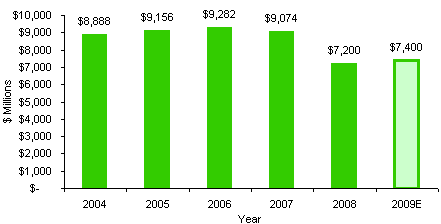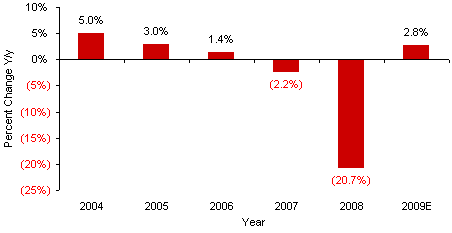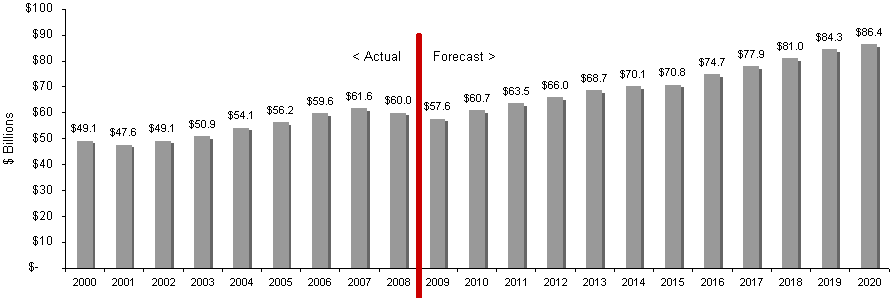IDEX Online Research Forecast - Specialty Jewelers: Santa’s Coming, but His Sack Is Lightly Loaded
November 09, 09
American specialty jewelers’ sales during the all-important 2009 holiday selling season are expected to be above last year’s dismal levels. While the gain is expected to be very modest, it will be the first piece of good news for the jewelry industry in more than a year.
However, before specialty jewelers start celebrating, it is important to understand that, while the IDEX Online Research forecast is calling for better sales in the 2009 holiday selling season versus 2008, those sales will be well below the levels achieved for several years prior to 2008.
The IDEX Online Research holiday sales forecast – for November and December – calls for about $7.4 billion of revenues for specialty jewelers. This will be almost 3 percent more than last year’s depressed $7.2 billion in sales. However, this year’s forecasted sales level is well below the average run rate of about $9.0 billion for the prior three years – 2005, 2006 and 2007. The last time specialty jewelers’ sales dipped to about $7.4 billion was during the recession in 2001. Prior to that, it has been more than a decade since jewelers’ holiday sales were in the $7 billion range.
The graph below summarizes our projected 2009 holiday sales levels versus the five prior years.
November-December Specialty Jewelers' Sales

Source: US Dept of Commerce
The graph below illustrates the percentage change in November-December holiday sales for specialty jewelers on a year-over-year basis. Last year’s sales decline of nearly 21 percent during the holiday sales period was the largest on record since 1959, when the U.S. Department of Commerce began tracking monthly sales.
Specialty Jewelers Sales Trends

Source: US Dept of Commerce
Here’s what is important for jewelers to understand: while jewelry sales have been under pressure, the recession of 2007-2009 will not derail 50,000 years of humans’ cultural affinity for jewelry. Holiday shoppers will be seeking jewelry.
Background – Jewelry Demand & Economic Cycles Correlate
Jewelry demand in the U.S. market correlates closely with economic cycles: when the U.S. economy is growing, jewelry sales typically soar; when the U.S. economy slows, jewelry sales typically fall first and fast.
The recession that began at the end of 2007 has had a significant negative impact on jewelry demand. By the end of 2008, monthly year-over-year sales comparisons for specialty jewelers showed a decline of as much as 22 percent.
Since the beginning of 2009, jewelry demand in the U.S. has shown “less bad” sales comparisons, similar to the U.S. economy. However, monthly and quarterly sales comparisons to the same period a year ago have remained negative through the third calendar quarter.
Fourth Quarter Should Show Positive Sales Comparisons
Fourth quarter 2009 specialty jewelers’ sales in the U.S. market are expected to show positive percentage comparisons.
Our assumptions call for negative sales comparisons through the end of the third quarter and perhaps into October, with positive comparisons in November, and December, driven by a number of factors, listed below, most of which are related to a recovering economy. Because jewelry sales are heavily weighted to the fourth quarter, these two or three months of positive comparisons will have a dramatic impact on overall annual sales levels. We are assuming that there will be no major “system shocks.”
Last year, specialty jewelers’ sales in November 2008 were down nearly 18 percent, and December 2008 sales were down roughly 22 percent; specialty jewelers’ sales for the two-month period were down 20.7 percent. We believe that specialty jewelers’ sales in November and December 2009 could be up by a low single digit level. This suggests that 2009 holiday sales will be about $7.4 billion, notably above last year’s $7.2 billion, but still below 2007’s $9.1 billion. The good news is this: late this year, we should start reporting sales comparisons using black ink, instead of the dreaded red ink that indicates a sales decline.
2009 Full Year Jewelry Sales to Be Down
Based on jewelry sales trends year-to-date as well as recently revised monthly sales data from both the Department of Commerce and the Bureau of Economic Analysis, our forecast model suggests that total jewelry sales in the U.S. may be down roughly 4 percent in 2009. This would result in 2009 jewelry sales of $57.5-to-$57.8 billion, down modestly from 2008’s $60.0 billion.
For specialty jewelers, the 2009 sales decline could be near 7 percent from 2008, yielding annual sales of nearly $26.0 billion to $26.5 billion. In 2008, specialty jewelers’ sales were $28.3 billion, down 6 percent from 2007’s $30.1 billion.
Short Term Outlook – Jewelry Industry Recovery Begins in 2010
Jewelry sales have been weak since early 2007. For the past three years, significant headwinds have put pressure on jewelry demand. While many of those headwinds still exist, they have abated somewhat. Further, tailwinds have begun to develop which will help boost demand for jewelers. The following are headwinds affecting jewelry demand, offset by tailwinds.
Near-Term Headwinds
Over the near term, several headwinds are affecting jewelry demand:
- Lack of Credit Availability – The banks say they have money to lend, but they aren’t doing it. Since up to 50 percent of all jewelry at the mass market level is sold on a monthly payment plan, availability of credit is critical to generating jewelry sales. Further, credit sales are important to jewelers because the average ticket for jewelry sold on credit is at least three times the size of the average jewelry cash ticket.
- Conspicuous Consumption Slowing – For a variety of reasons, consumers have cut back on conspicuous consumption. It may be that they have tighter budgets; it may be that they are trying to be sympathetic to their neighbor who just lost his or her job. Based on history, we believe that this will be only a temporary impediment to jewelry demand. During the Great Depression, some consumers continued to buy jewelry. Even during World War II, when the nation was focused solely winning the war at any cost, jewelry demand grew every year except one – 1944.
- Lack of New Products – Jewelry suppliers aren’t creating new, exciting merchandise in the current weak environment. Retail jewelers aren’t stocking new, exciting products; instead, they are opting for core jewelry which isn’t selling particularly well. When jewelers refuse to bring new merchandise into their stores – especially fast sellers – they aren’t creating a compelling reason for their loyal customers to come into their shops.
- Lack of Industry-Wide Promotion Focus – Unfortunately, the jewelry industry has no organization which coordinates overall jewelry marketing, primarily because the industry is so fragmented. Historically, De Beers oversaw diamond marketing in the U.S. However, it has abdicated this role in favor of forming a consortium of rough diamond producers to coordinate marketing. So far, there has been little progress from that diamond consortium And De Beers’ Everlon promotion will start late - on November 16. The World Gold Council provides some coordination for gold jewelry marketing, but its budget is very limited. A few jewelry buying groups have developed brands – mostly related to diamond jewelry and watches – but their efforts are also limited by budget. The lack of widespread jewelry branding also hinders the ability of the industry to market itself.
- Pricing Roulette – Consumers are seeking value, and they are shopping at merchants who offer merchandise with a clear, definable value. Unfortunately, jewelers often use the lowest common denominator to compete with these value merchants: price. Jewelers have confused consumers with their on-going price-based promotions; they sound more like used car dealers than purveyors of luxury goods.
- The Average Jewelry Ticket Is Down – It appears that the average ticket for jewelry is down 5-15 percent, depending on the item. The average ticket for high-end jewelers has declined more than for mass market jewelers selling popular-priced goods. Thus, even if unit sales are flat, total sales will be down if the average ticket is lower.
- Unemployment Levels Will Continue to Rise – While many economic indicators are showing positive signs, unemployment levels – a high-profile measure – has continued to rise, a trend that will likely continue well into 2010. One of consumers’ greatest fears related to the economy is the possible loss of their job. Unfortunately, unemployment levels are a lagging indicator: employers are slow to lay off employees at the beginning of a recession, and they are even slower to re-hire, even when it is clear that the economy is recovering. Rising unemployment levels often have a dampening impact on jewelry demand.
Near-Term Tailwinds
While the headwinds affecting jewelry demand may seem formidable, there are a number of tailwinds – positive factors – that will benefit jewelers and help boost their sales, including the following:
- U.S. Economy Recovering – The U.S. economy is showing vitality, after significant weakness over the past year. Three key factors are having a positive impact on the U.S. economic recovery:
- The U.S. government and the Federal Reserve threw all of their defenses and stimuli at the recession early in the economic decline, long before other nations implemented recovery plans. These stimuli are clearly having a positive impact.
- The U.S. economy is far more resilient than most people understand. History confirms that U.S. recessions in the past fifty years are less frequent and not as volatile as in the prior periods since the late 1700s.
- The Federal Reserve has engineered the stimuli to put the U.S. economy back on track. If there is one thing to be learned from past history, it is this: don’t bet against the Fed. The Fed may not be perfect, but overall its success record is enviable.
· More Shoppers in Malls – Jewelers report that shopper traffic is up, both in malls and in free-standing locations. With more shoppers in the market, the opportunity to generate sales increases.
· Increase in “Conversion Rate” – Jewelers report that they have increased the “conversion rate” – converting browsers to buyers – in their stores. In part, this is due to increased sales training; in part, it is due to shoppers who have finally realized that the world is not coming to an end, and they have loosened their purse strings.
· Bridal Jewelry Demand Remains Strong – Despite media reports to the contrary, the number of weddings does not decline in a recessionary period. The number of coupled who married in 2008 exceeded the number who were married in 2007. During 2009, we expect another increase in the total number of weddings. Jewelers report, however, that brides are spending less on their jewelry, and the average ticket for a diamond engagement ring is down at least 10 percent.
· Demand For Selected Jewelry Is Relatively Strong – Unique jewelry / fashion jewelry / custom jewelry demand is solid in the U.S. market. For consumers who are buying jewelry, they are seeking jewelry that provides differentiation for themselves.
· Competitive Landscape Remains Relatively Level – There is no “hot” must-own consumer electronics gadget or other $200-$500 retail ticket item vying for consumers’ discretionary dollars this year. This will benefit jewelers in the 2009 holiday selling season of November and December.
· Early-Bird Signs Point to Improvement in Consumer Spending – Merchants who typically emerge first from a recession are reporting stronger consumer demand. For example, sales of men’s suits are up, as men need those suits for job interviews, and, more importantly, for new jobs. MasterCard reported that jewelry sales rose by about 7 percent in October. The number of “temp jobs” that were created in October rose measurably. Employers are slow to rehire workers for full time jobs, but hiring temps is an early leading indicator that business is picking up.
· At Least 90 percent of Jewelry Shoppers Continue to Buy Jewelry – Jewelry sales at specialty jewelers are down about 10 percent; this is largely due to fewer transactions coupled with a little slippage in the average ticket. However, this means that at least 90 percent of all jewelry shoppers are in the market buying merchandise.
Long-Term Outlook for Jewelry Demand – Mid-Single Digit Market Growth
Longer term over the next several years, the U.S. jewelry industry is expected to grow by 4-5 percent annually, about 80-100 basis points greater than overall retail sales which are forecasted to grow by 3-4 percent over the long term.
The following factors are expected to fuel demand for jewelry for the longer term.
- Bridal demand is rising sharply.
- More life cycle milestone events such as births, confirmations, graduations, and other events – all of which are jewelry gift-giving opportunities – are occurring.
- The divorce rate is declining; this is positive for jewelers:
- More larger, higher-quality diamond jewelry will be sold to husbands for “same-wife, second-diamond” gifts.
- When couples renew their vows after years of marriage, they often give gifts of jewelry.
- Anniversary jewelry purchases will rise, since couples will remain married longer.
- Due to fewer divorces, alimony payments will be down, yielding more discretionary income for American households to spend on luxury goods such as jewelry.
-
- U.S. population and the number of households are growing. By 2050, there will be at least 60 million more women in the U.S. population, most of whom will be jewelry consumers.
- Consumers’ incomes are rising; higher-income consumers are the best customers for jewelry. By the end of this decade, about 20 percent of all American households will have incomes in excess of $100,000 annually. This group of shoppers spends much more heavily on jewelry than lower income consumer groups.
- Favorable consumer spending patterns will boost jewelry demand; luxury demand will recover, and younger consumers will play a major role in fueling demand in that market.
- An increase in female self-purchasers will fuel jewelry sales.
- Precious metal jewelry is increasingly seen as a “store of value.”
- Consumer demand is moving toward more fashion and unique jewelry. Both of these categories could help boost the number of trips that consumers make to their favorite jewelry store.
- Improved target marketing will help jewelers reach consumers with a high propensity for acquiring jewelry.
- Americans are born to spend. Shopping is an important cultural characteristic of Americans.
Despite casual assertions by the mass media that the current recession compares to the Great Depression of 1929-1934, the facts do not support these allegations. During the Great Depression, jewelry demand plummeted by 70 percent peak-to-valley; in the current recession, total annual jewelry demand will likely be down by 7-8 percent or so, peak-to-valley.
Long Term Sales Forecast for U.S. Jewelry Market
The following graph summarizes the actual and forecasted jewelry sales for the U.S. market over the long term. Clearly, the U.S. market represents a growth opportunity for the jewelry industry. By the end of 2011, jewelry sales could be back to levels achieved in 2007. Further, the sales progression assumes a modest recession around 2015.
| U.S. Jewelry Sales - Actual & Forecast |
